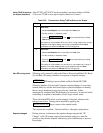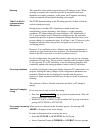
4/00 UDC 3300 Controller Product Manual 195
Rules
Table 5-34 is a list of rules for Accutune.
Table 5-34 Accutune Rules and Regulations
TUNE SP* Applicable Rule
X
TUNE On Demand tuning will work for all control algorithms except ON/OFF. Process
line out is not required.
X
TUNE On Demand tuning works for integrating processes.
X
SP tuning will work only for algorithm PID a or PID B selections; i.e., it will NOT work
with ON/OFF, Three Position Step, or PD+MR control algorithms.
X
SP tuning can tune on all local or computer setpoints except ramping setpoints; i.e.,
cannot be done during SP Ramp or SP Program or when using remote setpoint.
XX
Tuning is done in automatic mode.
XX
Tuning can be monitored or reconfigured using communications option.
XX
Tuning can be enabled via digital inputs.
XX
Tuning can be aborted by going to manual mode or disabling via configuration.
XX
When tuning is in progress, a large T appears in the upper display and disappears as
soon as tuning is completed.
XX
Can tune two independent loops.
X
Setpoint changes can be made during operation. The setpoint at the time tuning
starts is captured and Tune runs until completion, then proceeds to the new SP value
following the completion of tuning.
*SP ADAPT not available on Basic Model DC330B
How TUNE (demand)
tuning works
TUNE tuning provides virtually foolproof, trouble-free on-demand tuning
in the UDC 3300 controller. No knowledge of the process is required at
start-up. The operator simply enters the desired setpoint and initiates the
tuning.
The controller immediately starts controlling to the setpoint while it
identifies the process, calculates the tuning constants and enters them into
the Tuning group, and begins PID control with the correct tuning
parameters. This works with any process, including integrating type
processes, and allows returning at a fixed setpoint.
The tuning sequence will cycle the controller’s output two full cycles
between 0 % and 100 % (or configured output limits) while allowing only
a very small process variable change above and below the SP during each
cycle. The algorithm then calculates new tuning parameters and enters
them into the Tuning group. A large T appears in the upper display while
tuning is active.


















